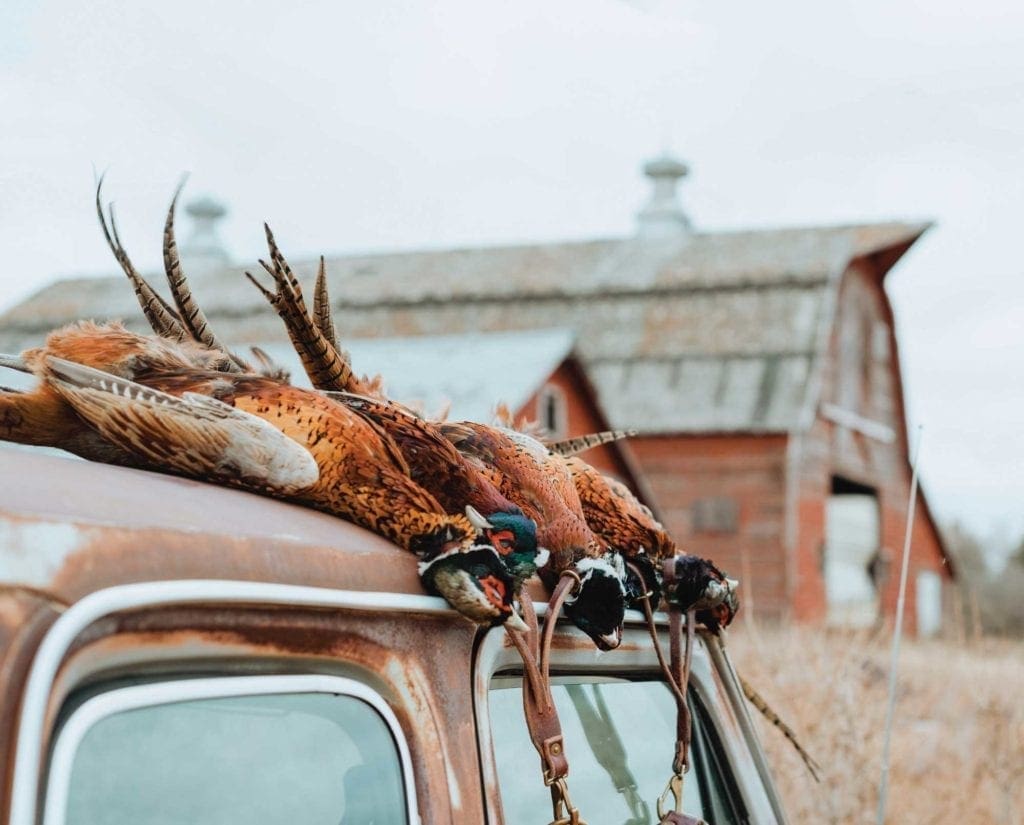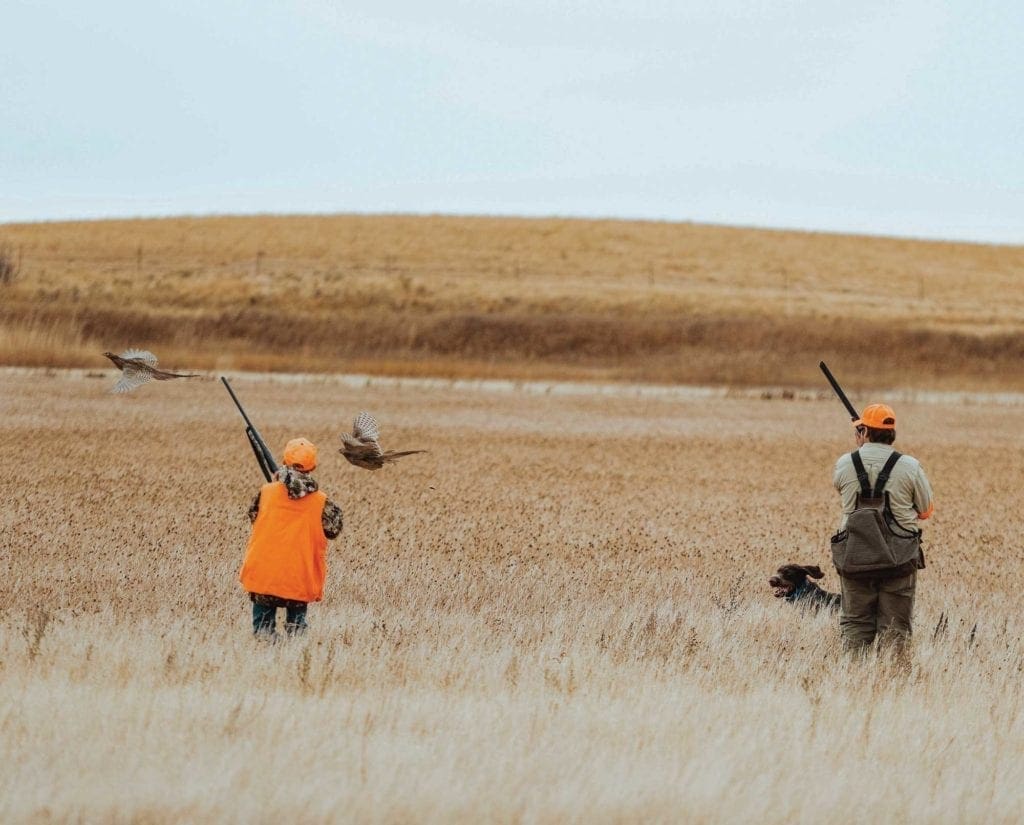Home » Pheasant Hunting » How the Non-Native Pheasant Became an American Icon
How the Non-Native Pheasant Became an American Icon
Project Upland is an editorial initiative to capture the cultures…
America’s love affair with pheasant hunting is undeniable, but why?
This is not a Romeo and Juliet‒type love story, where girl meets boy . . . girl’s dad dislikes boy . . . and through drama and emotional turmoil, fate brings the lovers together. America’s love for the pheasant developed rapidly, in terms of the world’s evolution, without much drama or resistance at all.
Pheasant are American immigrants. When distinguishing the hierarchy of upland species over beers at the bar, brush-worn, hardcore ruffed grouse hunters will ask you, “Why would you hunt a nonnative species?” That said, just look around hunting magazines, advertising, and social media . . . America’s love affair for the pheasant is undeniable.
The history of importing pheasants to America
If you share this affliction, Chris Dorsey’s Pheasant Days is a must read. He thoroughly researched the origins of this migrant to the melting pot of the United States, noting that our forefathers, such as Benjamin Franklin (actually, his son-in-law) and George Washington, brought their reverence for ring-necked pheasant from their English heritage to the New World of America around 1790 and thereafter. Although their attempts to implant these birds in the Colonies were unsuccessful, they tried—and there had to be a reason for it.
As Dorsey notes, the first successful transfer of pheasant to North America came from the West, not the East. Honestly, I had to do a “double take” when reading this, always assuming the birds came on ships from England or Spain. In fact, the first huntable population was successfully implanted in Oregon from China in 1892. To put this in perspective, that means pheasant hunting has only been available in the United States for around 125 years. That is not very long, considering native species, such as grouse and quail, have roamed our soils for eternity.
Pheasant rapidly spread across the nation through appropriate habitats, and the 1940s represented the heyday for hunters, a fascination that has exponentially grown to modern day.
The question, “How did America fall in the love with the pheasant?” was inherently implied, but maybe not outwardly answered in Dorsey’s book. Our forefathers certainly respected the birds from their experiences abroad, so this idea is not a huge surprise. To help provide an answer to this perpetual barroom debate, let’s explore some more . . .

The experience of shooting your first pheasant
Think back to the overall experience of shooting your first pheasant. Really, take a moment and think. Do it, Hutch . . . Do it!
As you walk the prairie, you can see for miles—acres upon acres of sheer potential. Your hunting partners walk to the sides, probably more experienced than you, and you watch closely to learn the game, step by step. The dogs feverishly quarter ahead, almost in a mesmerizing fashion, but fast-paced and stressful, too. Action is everywhere, and the anticipation of that first flush is almost too much to bear.
You see the dog get birdy, you know at least that much, and everything after happens in slow motion, a memory you’ll never forget. The first sense of a flush is the sound, a dog lunging through the cattails, and struggling wings on the reeds. The cackle sounds louder than expected, but immediately gives the bird away. A pressured decision must be made by a new hunter, in a split second, one that initially gives nightmares but comes naturally over time.
Your first thought is of mild panic.
“Is it a hen, or is it a rooster?”
The tail looks so long, almost enough to tickle your nose, and figuratively waves, slowly, “goodbye,” as the rooster catches wind for safety.
These telltale signs flick on the light of recognition in your mind, and you raise your shotgun to your cheek. The first shot may be behind; pheasants fly faster than you anticipated, but you regroup your lead, and the second barrel rings true.
The bird dog retrieves your trophy to hand, wings covering eyes and longtail flopping about. Without even pondering the moment or taking time to stroke the feathers, you strap the bird to your belt and move on to the next. There’s always another bird to find.
This story closely recounts my first pheasant, and I imagine it may be similar to yours, too—except I’m sure you caught up with the bird on your first shot, of course. That said, the first time a longtail “tickled my nose” made me want for more and has many Americans enamored in the same way.
The beauty of the pheasant
Pheasants are just simply beautiful birds, meant for magazine covers. Hens were built for camouflage, while obviously roosters stick out of the weeds like a sore thumb. Their feathers promote deep red, drooping cheeks, bronze to almost blaze-orange chests, yellowish and black-ticked wings, random purples and greens, and the teal—the shining teal color always gets me—stunningly iridescent in the sun. The pheasant rainbow is unique among North American birds.
If you look around the outdoor media world, pheasant are prominently promoted when it comes to upland game. Conservation groups, such as Pheasants Forever, have done a remarkable job at marketing pheasant hunting and conservation. Companies promoting firearms, dog products, hunting gear, and the like have taken advantage of America’s love for the pheasant and include the iconic bird in their promotional materials and strategic marketing plans. These efforts make pheasant visible to a wider and wider market on a year-to-year basis.

The pheasant hunting social experience
Pheasant can be relatively accessible, which is advantageous for learning upland hunters, as I once was. This doesn’t mean they are flushing everywhere, however, public land pheasant-hunting opportunities do exist throughout America’s landscape if you look for them. Pheasant can also be pen-raised and released, which increases opportunities for pheasant hunting through hunt clubs and game farms. This elevated accessibility makes pheasant a gateway gamebird for those wanting to learn the upland hunting game and traditions.
Pheasant hunting is a social event, often with camaraderie as a paramount factor in the fun. Sure, you can hunt pheasant by yourself—I enjoy hunting a coulee or fencerow solo with my pointing dogs—but I cut my teeth in the uplands hunting pheasant with friends and family.
Our lengthy drive from the forests to the prairies for pheasant camp provided all the anticipation a boy could handle. Small-town cafés, friendly locals, and conversations with farmers were always a favorite. Campfire stories, lies, liquor, and smoke proved a rite of passage. Planning the strategy of walking hunters, blockers, and dogs added to the intrigue. I’m not sure there is anything better than an afternoon nap or hitting the saloon at noon after a morning limit of birds.
Whether you are on the prairies or your local game farm, pheasant are hard to beat for learning the safety, practices, and strategy to enjoy the uplands on your own. With wide-open fields, pheasant hunting can often provide a steady and controlled environment for hunting’s trials and tribulations. From the effort of walking miles for birds, the dog work of flushers or pointers, to the challenge of wingshooting, pheasant offer the gamut of upland lessons and possibilities. Then there is the food. Like the imports they are they can offer cultural spins on such recipes as Mediterranean rouladen or American classic like biscuits and gravy.
So the next time you encounter that barroom debate, hopefully on the uplands and not politics or religion, remind everyone that China should be thanked for exporting pheasant to America back in the day—no trade embargo here. Upland hunters nationwide, young and old, now have more opportunities to hunt this gateway gamebird.
It’s not quite the story of Romeo and Juliet. However, considering the earth is more than 4.5 billion years old, America’s 125-year affair with pheasant is akin to love at first sight.
Project Upland is an editorial initiative to capture the cultures and traditions of upland bird hunting. We seek to inspire a future generation of upland bird hunters to understand the essence of hunting traditions and the critical cause for conservation.





got an invite to go to south Dakota in 1968 been going back ever year since, i am 83 and count my many blessings ever day, , one of which is a fine son, who takes me to south Dakota ever October for a week of pheasant hunting and the fine farmer family who lets us hunt,on their property, any time you can spend a week with your son, it s about as good as it gets,
good article keep up the good work
I agree, brown, grey or gaudy, there is no such thing as an unworthy upland bird!
Another consideration; pheasants gave upland gunners an opportunity to pass along their passion, most certainly. But, being the most successful transplant, perhaps they took the brunt of pressure off dwindling (native) prairie grouse until natural habitat can be restored?
Nice article, setters forever!